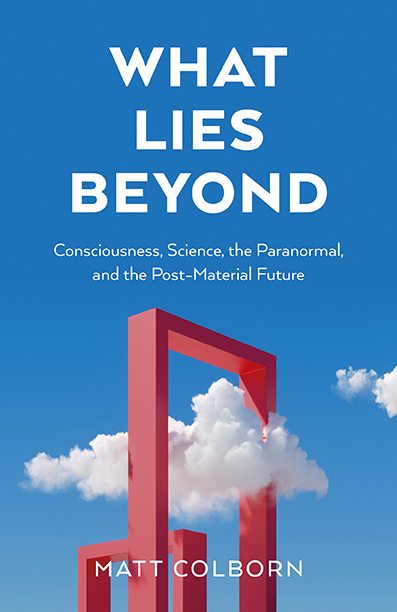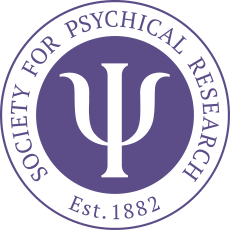
Reviewed by Nemo C. Mörck
Many readers may recognise Dr Matthew Colborn from his podcast What Lies Beyond; others have seen his name in the Fortean Times or will remember him for his previous book, Pluralism and the Mind (Colborn, 2011). His latest book, What Lies Beyond: Consciousness, Science, the Paranormal, and the Post-Material Future, concerns parapsychology, but as its subtitle makes clear also much more.
What Lies Beyond is a concise book, about 177 pages plus endnotes and references. It has been written with lay readers in mind and Colborn explains concepts when appropriate. In the introduction, Colborn relates that he participated in a dream precognition study in 2022. During one night he dreamt that “One male bear tells stories to the female bear to get her to marry him” (p. 2). This allowed him to correctly identify the target image: “a baby polar bear lying on top of its mother” (p. 3). I have had a similar experience during a telepathy study — most of the images I saw were not relevant — but one stuck out, enabling me to correctly identify the target. Taken alone, these experiences are not convincing evidence, but they suggest that the mind may have hidden capabilities. Intriguingly, Colborn suggests that,
The large body of oft-shunned ‘paranormal’, ‘mystical’, or ‘psychic’ human experiences just might hold the keys to a better future (p. 4).
He notes that these phenomena tend to be ignored, and, like Prince (1923), he perceives a “boundary of the acceptable” (p. 12). Colborn suggests that it appears, for example, in a debate between psychedelics researchers David Luke and Robin Carhart-Harris (Breaking Convention, 2017): ”Luke is open to alternative approaches, has had entity experiences, and has also conducted research in parapsychology. Carhart-Harris tends to stick to the conventional side of the boundary, and this shows in his responses to Luke” (p. 12).
Colborn writes: “One could claim that debates over fringe phenomena are only the concern of specialists. Yet the outcome of the broader disputes about consciousness surely matters a great deal for everyone” (p. 13). Unfortunately, consciousness is not easy to explain. Colborn covers different theories and notes that one, Integrated Information Theory (IIT), “was condemned as ‘pseudoscience’ in an open letter written by 124 researchers” (i.e., Fleming, et al., 2023) — somewhat reminiscent of the famous statement against astrology, signed by 186 scientists (Bok, et al., 1975), but notable not by Carl Sagan or Paul Feyerabend.
Eventually, Colborn leaves consciousness as an unexplained mystery and takes us back to Joseph Glanvill’s investigation, in 1663, of a poltergeist case, the Drummer of Tedworth. He believes that Glanvill with his book, Saducismus Triumphatus, wished “to establish the reality of phenomena that couldn’t be explained in materialistic or ‘atheistic’ terms” (p. 40). Glanvill was a member of the Royal Society, but its members were not in agreement about whether they should investigate such cases. In Colborn’s historical overview predecessors to the modern sceptics also briefly appear: ”From about 1700 to 1750, they [humanist free-thinkers] waged a campaign of ridicule and scepticism against ideas that they considered superstitious” (p. 42).
Naturally, the sceptics’ attempt to disenchant the world was not successful, and with the rise of Spiritualism in the wake of the Fox sisters researchers found themselves faced with a number of extraordinary claims. The SPR was founded, in 1882, partly to investigate such claims. The history about the SPR and its early work has been covered many times before (e.g., Gauld, 1968). Colborn regards the founding “as a response to the ongoing decline of traditional religious beliefs and the seemingly unstoppable rise of materialist science” (p. 46). However,
By the early twentieth century, psychical research was being marginalised. In part this was due to the rise of behaviourism, a new form of psychology that saw animals and humans as blank slates whose nature could be entirely accounted for by chains of learned behaviour (p. 50).
Nevertheless, paranormal belief is widespread and paranormal experiences are common, though: “They are often seen as exceptional, perhaps intrusive — certainly not part of the everyday fabric of existence” (p. 58). Colborn gives examples and shows that he is aware of possible normal explanations, but clearly feels that something unexplained remains. He notes that when mainstream researchers bother to comment on out-of-body experiences (OBEs) or near-death experiences (NDEs) they usually do not address the more provocative and, for parapsychologists, interesting aspects, such as veridical perception (Holden, 2009).
Colborn does not outline the debates that have raged about famous cases, such as Pam Reynolds. He acknowledges that many experiences appear hallucinatory, yet can be impactful. For example, he notes that the well-known and colourful sceptic Susan Blackmore under the influence of marijuana had an OBE, that contributed to her decision to delve into parapsychology. However, despite feeling very real she noted differences between her perception and later observations which “seemed to imply that the OBE, although very vivid, was basically hallucinatory” (p. 88). Likewise, Roll (2013) noted differences that made him conclude that his OBEs were hallucinatory experiences.
In the second half of the book Colborn starts to engage more directly with experimental parapsychology, notably ganzfeld and remote viewing studies. His overview is necessarily somewhat brief. He has written with lay readers in mind and does not delve into details. Colborn admits: “For me, the remote viewing and ganzfeld databases contain some of the best evidence that psychic functioning is real” (p. 85). Others, such as Richard Wiseman, remain unconvinced and argue that extraordinary claims require extraordinary evidence.
Colborn also covers Blackmore’s history — she started out as a believer and ended up as a sceptic, more unsure about what to believe. The story about Blackmore is interesting, but it has been told so many times before. Many other “conversion” experiences are as interesting. For example, by the time Louie Savva finished his PhD Dissertation on parapsychology (Savva, 2014) he had lost interest and had a blog titled “Everything is pointless” — Savva is now a hospital chaplain.
Toward the end of the book Colborn comments on technocracy and transhumanism.
Those advocating technotopian futures tend to take it for granted that the universe and human lives are ultimately ‘pointless’. This latter dogma clashes with mystical experiences that powerfully suggest to the experiencers a universe pregnant with meaning, purpose, and vital force (pp. 143-144).
I think the reader would have benefited from more examples in this part, Colborn has written fiction before and is surely familiar with many fictitious dystopian futures (e.g., Gattaca). Instead, he uses Aldous Huxley’s contrasting novels, the dystopian Brave New World and utopian Island. Unfortunately, his criticism of transhumanism, technocracy, and the modern world is clearer than the alternative, which he tries to describe in the final chapter (see also Colborn, 2018).
Colborn argues that advocates for technocracy ignores mystical and psychic experiences: “This may be a crucial omission because such experiences suggest that every human has deep, intimate connections with other people, nature, and the universe as a whole” (p. 144). Colborn associates technocracy with a depressing worldview. However, both he and the authors he cites also appear to have a rather depressive view of the modern world: “Institutions like politics and big business tend to encourage ‘sociopathy’ and sociopathic practices” (p. 145) and may even come across as alarmist: “As I write, much of the world is experiencing endless heatwaves, wildfires, droughts, and floods” (p. 146).
Overall, What Lies Beyond is a well-written book that I would recommend particularly to newcomers. However, readers more familiar with parapsychology and its findings might find the sections about consciousness and transhumanism more interesting.
References
Bok, B. J., et. al. (1975). Objections to astrology: A statement by 186 leading scientists. Humanist, 35(5), 4-6.
Breaking Convention (2017). Psychedelics debate: The brain and beyond.
Colborn, M. (2011). Pluralism and the mind: Consciousness, worldviews and the limits of science. Imprint Academic.
Colborn, M. (2018, July 27). Return of the wild.
Fleming, S. M., et al. (2023). The Integrated Information Theory of consciousness as pseudoscience. PsyArXiv
Gauld, A. (1968). The founders of psychical research. Schocken Books.
Holden, J. M. (2009). Veridical perception in near-death experiences. In J. M. Holden, B. Greyson, & D. James (Eds.), The handbook of near-death experiences: Thirty years of investigation (pp. 185–211). Praeger.
Prince, W. F. (1923). The enchanted boundary. Psyche, 3(4), 298-316.
Roll, W. G. (2013). A lifetime of searching. In R. Pilkington (Ed.), Men and women of parapsychology, personal reflections: Esprit, volume 2 (281-293). Anomalist Books.
Savva, L. (2014). Is some of the evidence for ostensible precognition indicative of Darwinian adaptation to retrocausal influences? [Doctoral dissertation, Goldsmiths, University of London].
Acknowledgement
Melvyn Willin kindly read and commented on the first draft.

